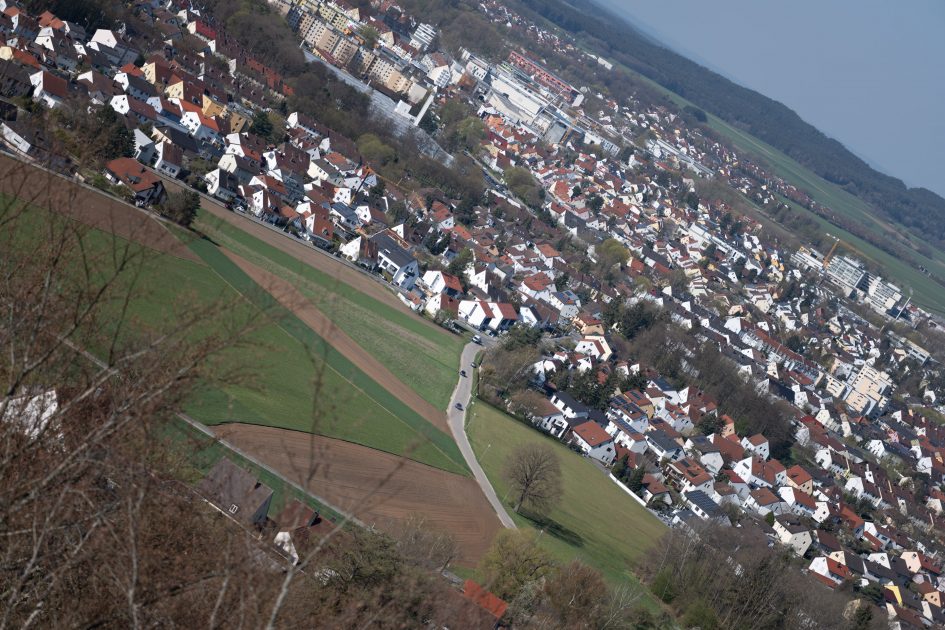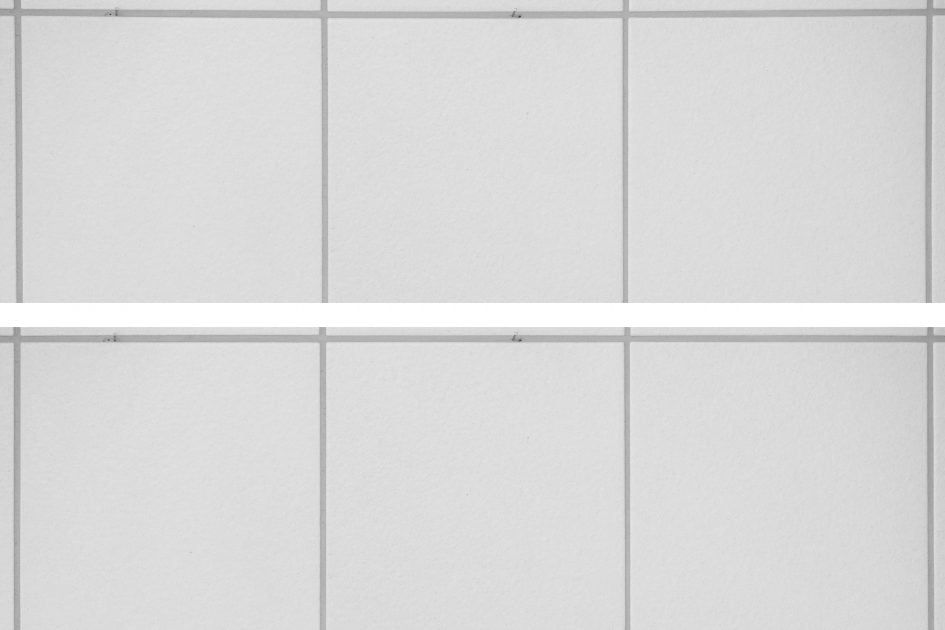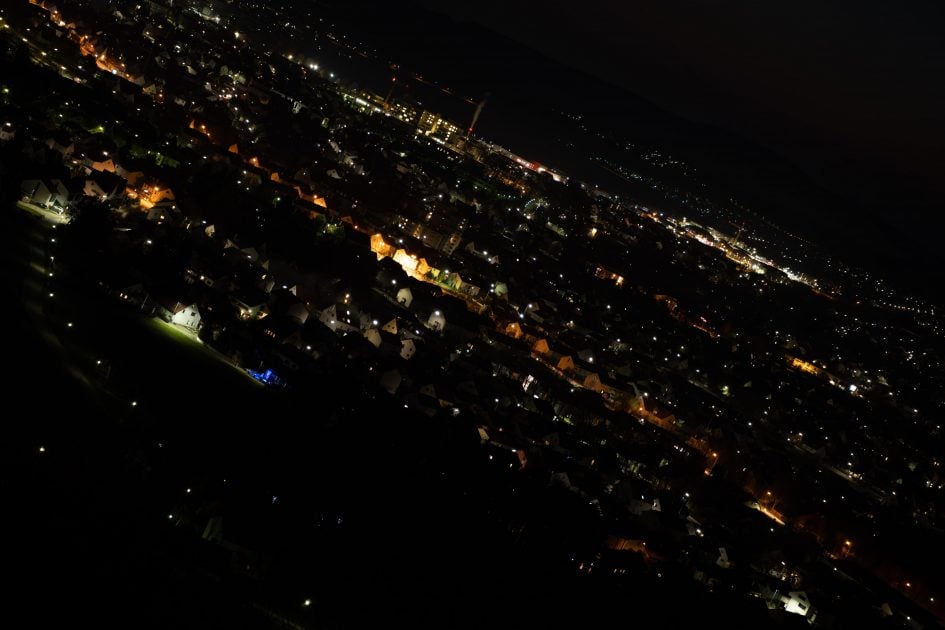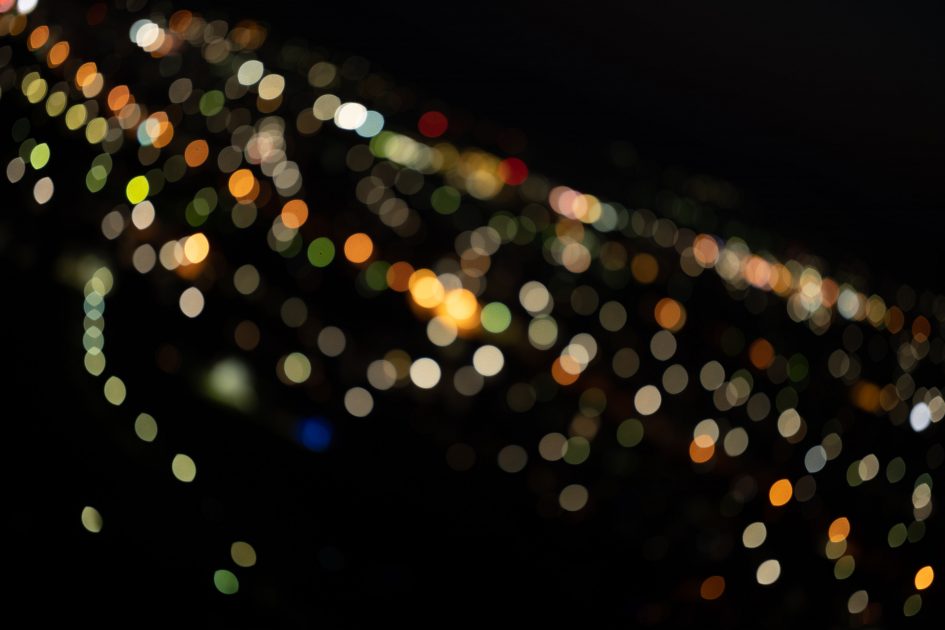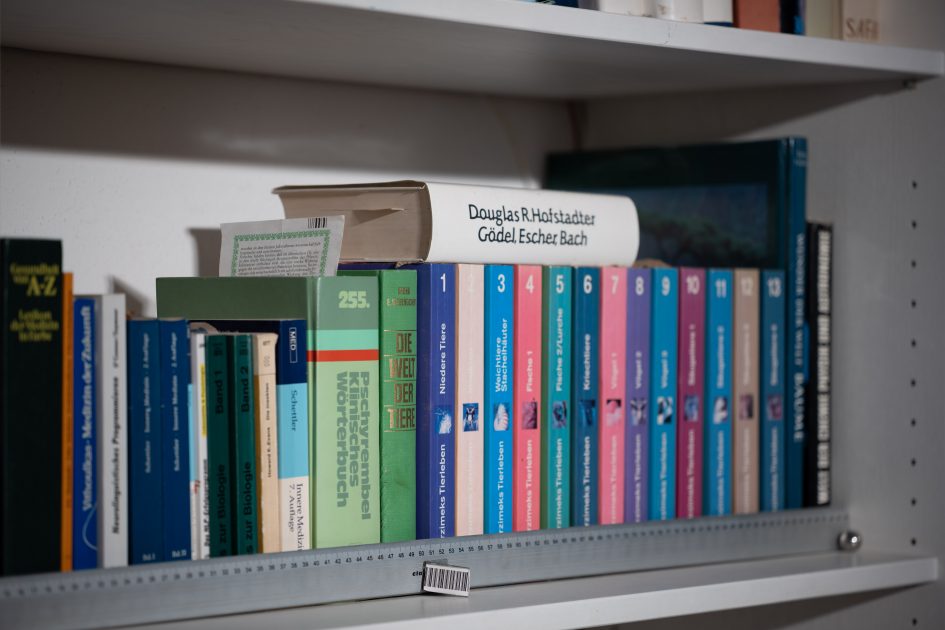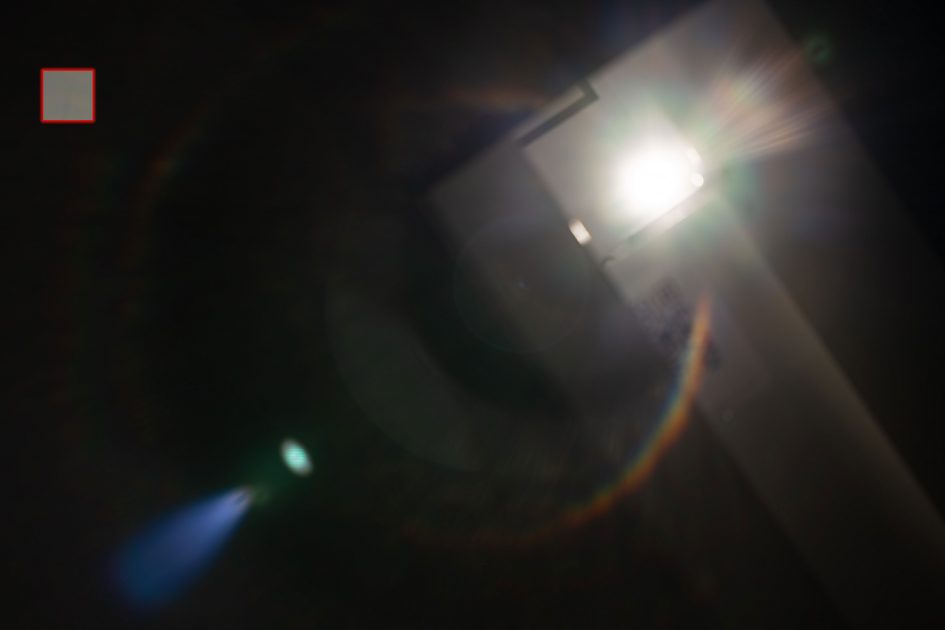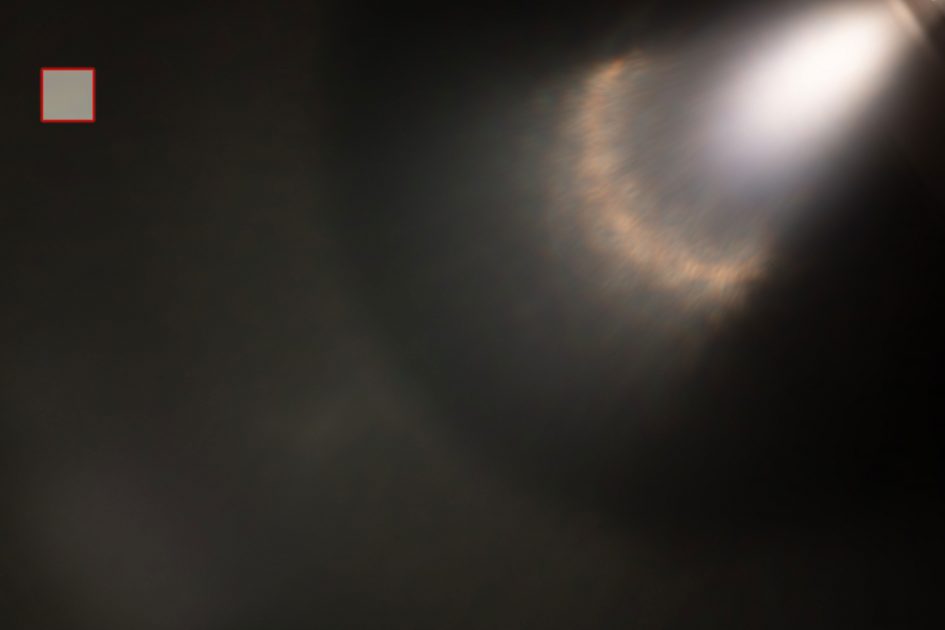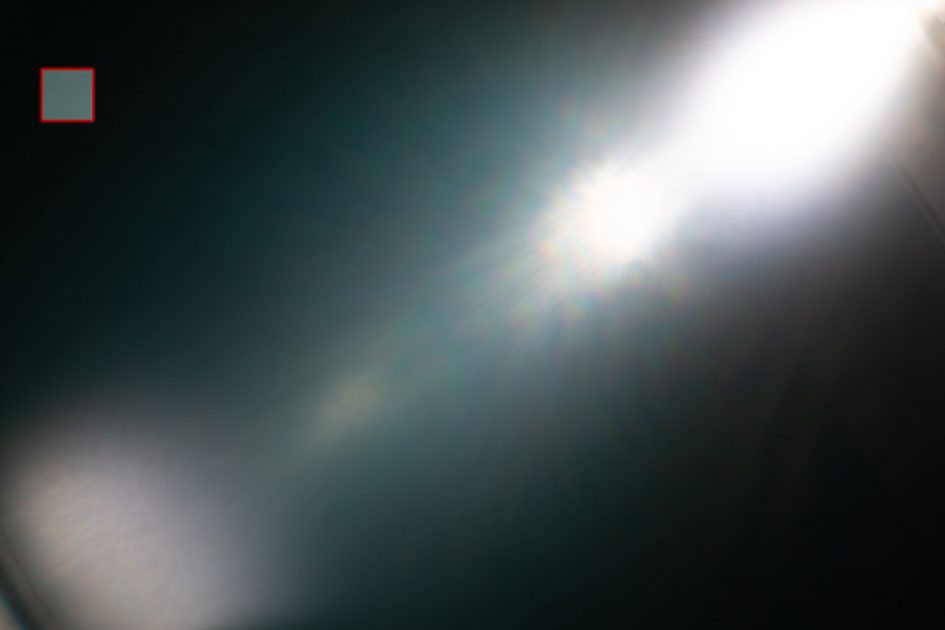Laowa 100mm f2.8 2x Macro APO review
-
-
Written by Thomas
Quality
Testing: Longitudinal Chromatic Aberration and focus shift
Lenses with focal ratios of f2.8 or larger are often prone to longitudinal color aberrations (loCA, a.k.a. “axial color” or “bokeh CA”). These show up as magenta coloration in the foreground and greenish hues in the background and are not easily corrected in post-processing. The Laowa 100mm f2.8 2x Macro APO shows only a bit of loCA at normal distances and it does not become stronger when closing in. Focus shift is hardly discernible.
Laowa 100mm f2.8 2x Macro APO longitudinal Chromatic Aberration (loCA)
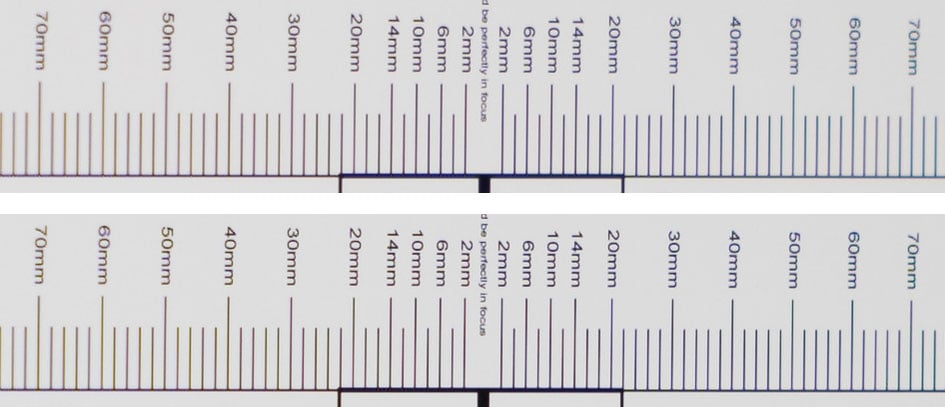
Above: Shot at 4m distance, f2.8 (top), f4.0 (bottom); 100% crops, left = foreground, right = background
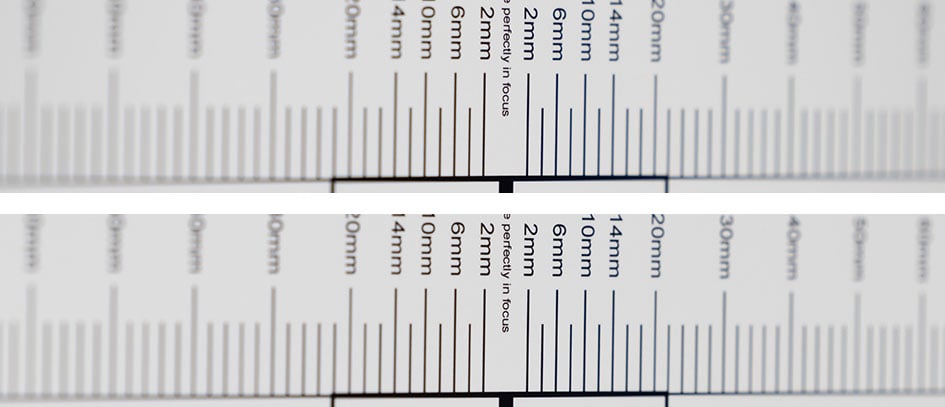
Above: Shot at 1m distance, f2.8 (top), f4.0 (bottom); 25% crops, left = foreground, right = background
The following real life shots show that the Laowa 100mm f2.8 2x Macro APO has a bit of purple fringing around high-contrast edges in the focus plane and a small amount of color aberrations around specular highlights:

Above: Laowa 100mm f2.8 2x Macro APO at f2.8, 100% crop, click image for 4k version
Above: Laowa 100mm f2.8 2x Macro APO at f2.8, 100% crop, click image for 4k version
The Sigma 105mm f2.8 DG DN Macro Art is practically free of these effects (see here).
Sharpness and contrast
Let’s have a look at the theoretical performance of the Laowa 100mm f2.8 2x Macro APO first and compare it to the Sigma 105mm f2.8 DG DN Macro Art:
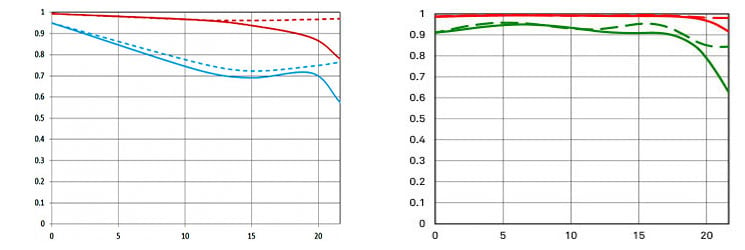
Above: Laowa 100mm f2.8 2x Macro APO (left), Sigma 105mm f2.8 DG DN Macro Art (right), both at infinity
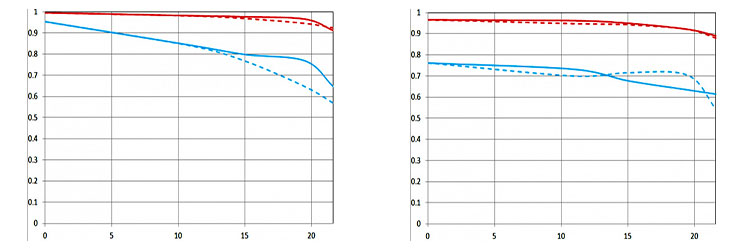
Above: Laowa 100mm f2.8 2x Macro APO at 1:1 (left), 2:1 (right)
These MTF charts show the computed lens-performance of lenses wide open without influence of diffraction at 10 line-pairs/mm (red) and 30 lp/mm (blue/green). The top two charts show the performance at infinity. The second set of charts show the performance of the Laowa at 1x and 2x magnification. Higher values are better (more contrast) and the closer the dotted and solid lines are together the less contrast dependents on the orientation of the test-pattern (less astigmatism). The x-axis displays the distance from the optical axis (=center of the sensor) in mm. I’ll show you the real-life performance at 4 mm (“center”), 13 mm (APS-C/DX-corner), and 20 mm (FF/FX-corner) on a on a 45MP Nikon Z7 camera.
From the charts at infinity resolution of the Laowa 100mm f2.8 2x Macro APO should have less contrast and acuity than the Sigma 105mm f2.8 DG DN Macro Art except at the exact center. Looking at the close-up performance the Laowa reveals its design as a macro lens: performance at 1x magnification looks better than at infinity.
Let’s see how this theoretical performance translates into real life results in the sharpness test based on Siemens-stars. Shooting distance was 45x focal length i.e. at around 4.5m. Processing was done in Lightroom 10.2/CRAW 13.2 from RAW to Adobe Color profile with CA compensation applied. Noise-reduction is set to 0, sharpening to 50/0.5/36/10, with no extra tone, color, or saturation adjustment. White-balance was adjusted to a neutral white and I did some exposure compensation to make the brightness of all crops match. So you will not see light fall-off in the corners.
The following 100% crops show the Laowa 100mm f2.8 2x Macro APO from f2.8 down to f11 compared to the Sony FE 90mm f2.8 Macro G OSS and Sigma 105mm f2.8 DG DN Macro Art shot on a Sony A7R II at f2.8. With linear resolution of the 45MP Z7 sensor only 4% higher than from the 42MP A7R II, identical test set-up, and identical RAW processing, comparability between the test-shots should be very good.
Laowa 100mm f2.8 2x Macro APO compared; 100% crop from center, APS-C/DX-corner, FF/FX-corner

Above: Laowa 100mm f2.8 2x Macro APO at f2.8

Above: Sony FE 90mm f2.8 Macro G OSS on a Sony A7R II at f2.8

Above: Sigma 105mm f2.8 DG DN Macro Art on a Sony A7R II at f2.8

Above: Laowa 100mm f2.8 2x Macro APO at f4.0

Above: Laowa 100mm f2.8 2x Macro APO at f5.6; also available at f8.0, f11
At f2.8 the Laowa 100mm f2.8 2x Macro APO is softer across the sensor than the Sony and especially the Sigma. Stopping the Laowa down to f4.0 improves acuity visibly but still not to the level which the Sigma already produces at f2.8. The test also showed the Laowa to have practically no field-curvature. Overall the Laowa delivers good sharpness albeit not on the level the Sigma shows.
Performance at long distances
As performance of lenses also depends on the shooting distance I present another series of test-shots of a city around 1 km away. Processing was done in Lightroom 10.2/CRAW 13.2 from RAW to Adobe Color profile with CA compensation switched on and some Vignette compensation manually applied. The Sony and Sigma was developed with the built-in lens profile compensating vignetting and CA. Noise-reduction is set to 0, sharpening to 50/0.5/36/10, with no extra tone, color, or saturation adjustment. I used manual focus at the largest aperture and did not change focus for other apertures.
The following image shows the complete scene wide open to give you an impression of the angle of view. Following the main image are 100% crops from the center, APS-C/DX-corner, and FF/FX-corner from the Laowa 100mm f2.8 2x Macro APO compared to the Sony FE 90mm f2.8 Macro G OSS and Sigma 105mm f2.8 DG DN Macro Art shot on a Sony A7R II at f2.8. The Sony and Sigma were shot at other days under a bit less clear atmospheric conditions. As usual I have selected the diagonal that provided the better corner results as almost any lens is a bit decentered.
You can access the large originals but please respect our copyright and only use those images for personal use.
Above: Laowa 100mm f2.8 2x Macro APO at f2.8
Above: Laowa 100mm f2.8 2x Macro APO at f2.8; 100% crops, click image for 4k version, here for large original

Above: Sony FE 90mm f2.8 Macro G OSS on a Sony A7R II at f2.8; 100% crops, click image for 4k version, here for large original
Above: Sigma 105mm f2.8 DG DN Macro Art on a Sony A7R II at f2.8; 100% crops, click image for 4k version, here for large original

Above: Laowa 100mm f2.8 2x Macro APO at f4.0

Above: Laowa 100mm f2.8 2x Macro APO at f5.6; also available at f8.0, f11
Again, the 100% crops of the Laowa look a little softer than from the Sony or Sigma – especially in the FF/FX-corner. Stopping down to f4.0 helps the APS-C/DX image-circle but the FF/FX-corner not profit much.. Again the Laowa delivers decent performance albeit not on the level the Sigma (or Sony) does.
Vignetting and distortions
To make it easier to see light fall-off in the corners of a full-frame sensor I’ve arranged a series of shots with the Laowa 100mm f2.8 2x Macro APO at different apertures. All images were developed to the same brightness in the center.
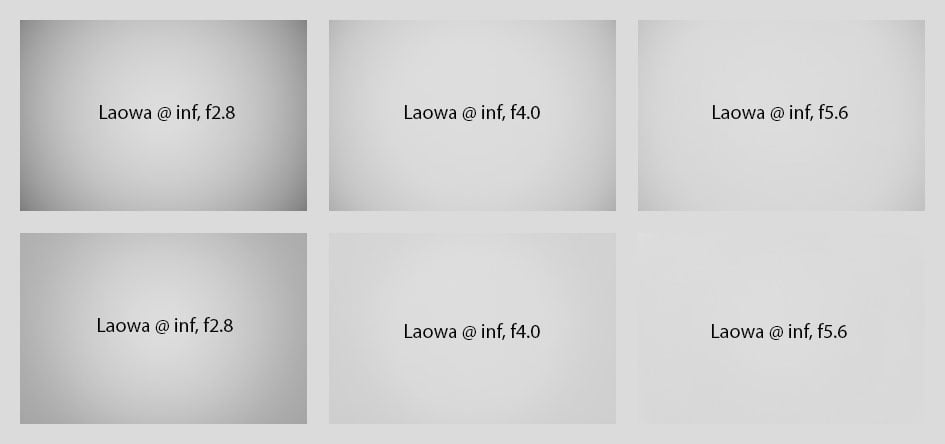
Above: Laowa 100mm f2.8 2x Macro APO at infinity without vignette compensation (top) / vignette compensation at +31/50 (bottom)
The sample images above show that the lens has pretty strong vignetting at f2.8 when focused at infinity. Setting vignette compensation manually to +31/50 in Lightroom/CRAW lifts the extreme corners about 0.6 EV at f2.8 and eliminates vignetting at f5.6 completely.
As is typical with most lenses, vignetting is reduced when focusing closer. See the following images at 1x and 2x magnification shown without any vignette compensation. So vignetting is not a problem at macro shots.
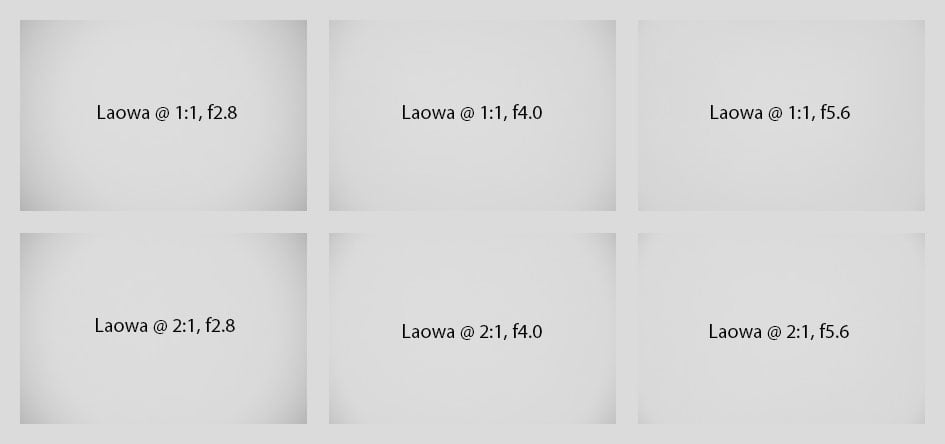
Above: Laowa 100mm f2.8 2x Macro APO at 1x (top) / 2x (bottom) magnification without vignette compensation
Distortions are of a mild pin-cushion type at 2m distance. They are easily corrected with a compensation of -3 in Lightroom/CRAW.
Distortions: Laowa 100mm f2.8 2x Macro APO, as is (top) / with distortion compensation at -3 (bottom)
In close-up shots you hardly notice any distortions as can be seen in this 1:1 macro shot.
Rendering of point-light sources at night-shots
Night-shots pose a different challenge for lenses as the contrast is even higher than under bright sun and point-light sources can reveal some weaknesses such as coma, haloing and colour-aberrations that do not show up as prominently in other test-shots. The 100% crops below the main image show the effect of coma in the FF/FX-corner of the Laowa 100mm f2.8 2x Macro APO at different apertures:
Above: Laowa 100mm f2.8 2x Macro APO at f2.8; click image for 4k version, here for large original

Above: Laowa 100mm f2.8 2x Macro APO; 100% crops from the FF/FX-corner at f2.8 (left), f4.0 (middle), f5.6 (right)
The Laowa 100mm f2.8 2x Macro APO produces only a small amount of coma wide open. The test also shows no color artifacts around bright streetlights at f2.8.
Bokeh quality
This test is for the rendering of point-light sources in an out-of-focus background. The circle of confusion that is produced by this test is pretty indicative of Bokeh performance (in the background) and light fall-off. Ideally the out-of-focus image of the point-light is evenly lit and perfectly circular, with no “onion-rings”, and without coloration. Large aperture lenses normally produce an effect known as “cat’s eye” the further away from the optical axis the point-light is projected. This is due to optical vignetting in the lens barrel when light enters the lens from an angle.
The crops below the main image are from the center, APS-C/DX-corner, and FF/FX-corner resized to make them comparable across all my reviews.
Above: Laowa 100mm f2.8 2x Macro APO at f2.8
Above: Laowa 100mm f2.8 2x Macro APO at f2.8; click image for 4k version

Above: Laowa 100mm f2.8 2x Macro APO at f4.0

Above: Laowa 100mm f2.8 2x Macro APO at f5.6
The diameter of the Bokeh balls in the center is determined by the entrance pupil of the lens. So the Laowa produces Bokeh balls almost as large as from the Sigma 105mm f2.8 DG DN Macro Art. Compression of the circle towards the corners is stronger than from the Sigma at f2.8 but is gone at the APS-C/DX-corner at f5.6. The circle of confusion in the center stays perfectly round up to f8 . The inside of the Bokeh balls is pretty smooth and there is only a bit of outlining.
Now let’s see how this analysis of out-of-focus point-light sources translates into Bokeh-performance shooting a book-shelf. Crops are from the foreground, middle-ground, and background resized to make them comparable across all my reviews.
Above: Laowa 100mm f2.8 2x Macro APO at f2.8
Above: Laowa 100mm f2.8 2x Macro APO at f2.8; click image for 4k version, here for large original
Above: Sigma 105mm f2.8 DG DN Macro Art on a Sony A7R II at f2.8; click image for 4k version, here for large original
Both the Laowa and the Sigma look pretty similar in the crops above with the Sigma seeming a bit less soft in the foreground and middle-ground. Both lenses show no greenish tinge from loCA.
Looking at another crop (now at 100%) from the same images showing the ruler reveals the Lowa rendering a bit smoother Bokeh than the Sigma which shows a slight tendency for double contours (at “59” and beyond).
Above: Laowa 100mm f2.8 2x Macro APO at f2.8; click image for 4k version, here for large original
Above: Sigma 105mm f2.8 DG DN Macro Art on a Sony A7R II at f2.8; click image for 4k version, here for large original
Close-up performance
The Laowa 100mm 2x macro lens goes down to 2x magnification (2:1). The following images were shot wide open at 1:1 and 2:1 magnification where the area of sharp focus is just 24 x 36mm resp. 12 x 18mm. The crops shown below are from 0mm, 14mm, and 21mm off the center of the sensor respectively. Each row of crops is from the same shot, focused optimally for the center. So this is the best results you can get from a single shot as any issues with field curvature would show up here.

Above: Laowa 100mm f2.8 2x Macro APO at f2.8, 1:1; 100% crops

Above: Laowa 100mm f2.8 2x Macro APO at f2.8, 2:1; 100% crops
The Laowa 100mm f2.8 2x Macro APO produces pretty sharp results even at f2.8 with a slight softening towards the FF/FX-corner and almost no field curvature.
The next set of images was shot from low ISO b&w film negativ at 1:1 magnification. So the “noise” that you see in the crops is actually the film grain. The crops shown below are from 4mm, 14mm, and 18mm off the center of the sensor respectively. The lens was focused specifically for each crop which eliminates any residues of field curvature. So this is the best result you can get from focus stacking multiple shots with the Laowa lens.
Laowa 100mm f2.8 2x Macro APO; 100% crop from center, APS-C/DX-corner, FF/FX-corner
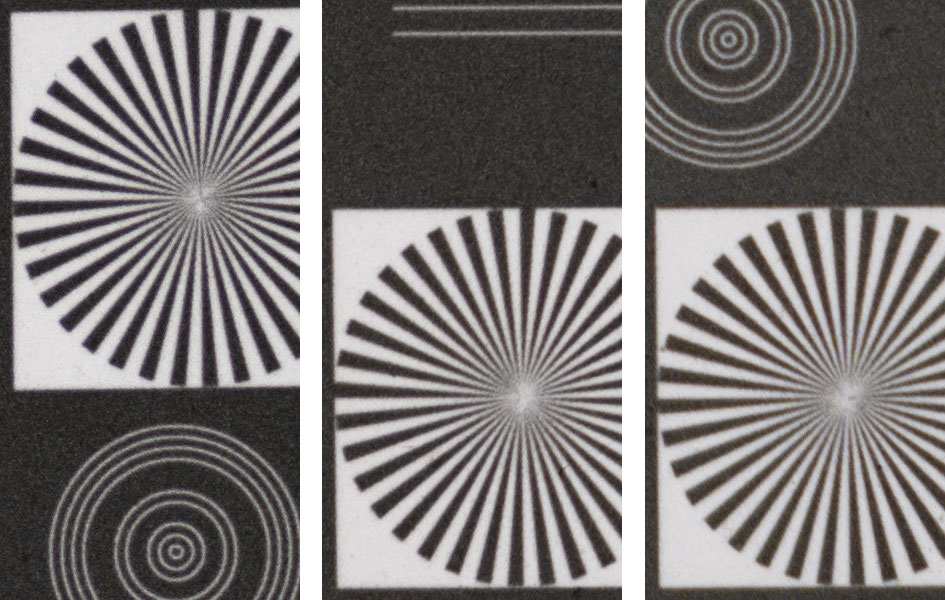
Above: Laowa 100mm f2.8 2x Macro APO at f2.8, 1:1; 100% crops
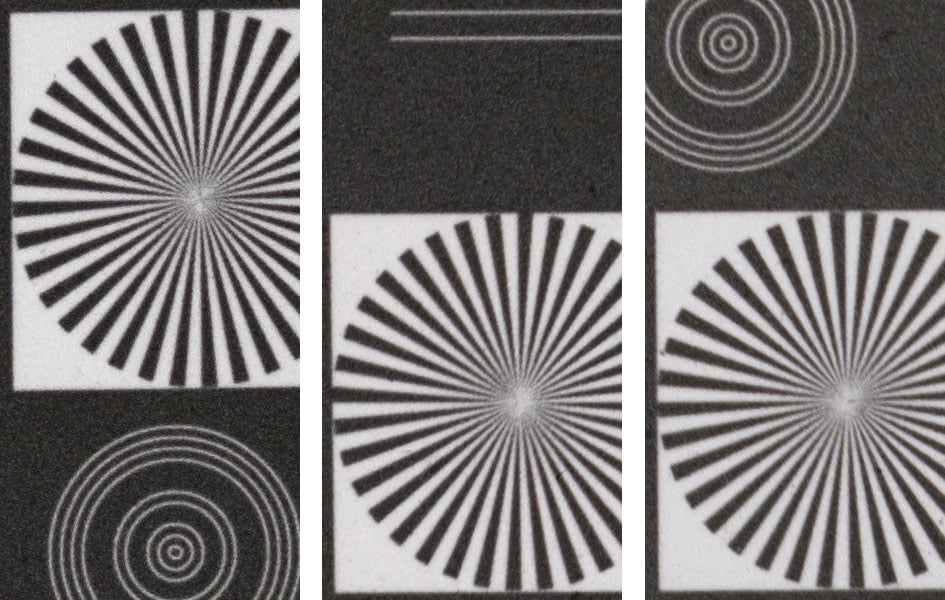
Above: Laowa 100mm f2.8 2x Macro APO at f4.0, 1:1; 100% crops
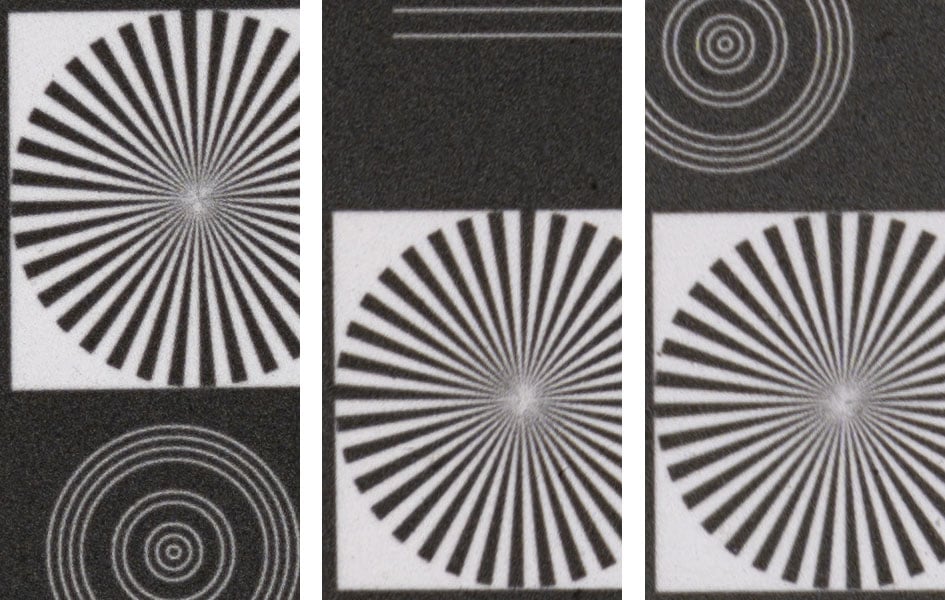
Above: Laowa 100mm f2.8 2x Macro APO at f5.6, 1:1; 100% crops
Overall contrast of the Laowa is a bit muted and fine details appear somewhat soft especially outside the center. Acuity profits from stopping down to f4.0 or even f5.6. For comparison have a look at the Sigma 105mm f2.8 DG DN Macro Art which is clearly better than the Laowa or the Sony FE 90mm f2.8 Macro G OSS which is even softer at the FF/FX-corner.
Flare, ghosting, and sun-stars
Catching a strong light-source shining directly into the lens is always a risky business: it could produce strange colorful ghost-images or reduce contrast considerably through flare and glare. The appearance of flare and ghosting depends on factors like the aperture and the angle of the light hitting the lens. So to judge the proclivity of Laowa’s 5x Ultra Macro for these artifacts I went through a series of well calculated shots against a strong light source to provoke glare and ghosting. The lens hood was mounted in all shots and focus was set to around 10m where the front lens group is deeply recessed in the lens barrel. Following are three of the more extreme example results. The little bright square inset in the upper left shows the respective area with an exposure compensation of +3 EV to make it easier to see which levels of black the lens renders at that point:
Above: Glare and ghosting from strong light hitting the Laowa 100mm f2.8 2x Macro APO at f.-8; click image for 4k version or here for +3 EV exposure compensation
Above: Flare from strong light hitting the Laowa 100mm f2.8 2x Macro APO at f2.8; click image for 4k version or here for +3 EV exposure compensation
Above: Flare from strong light hitting the Laowa 100mm f2.8 2x Macro APO at f11; click image for 4k version or here for +3 EV exposure compensation
The Laowa 100mm f2.8 2x Macro APO is pretty prone to flare and ghosting and suffers greatly reduced overall contrast from veiling glare in adverse contra light situations. The typical streak occurring when the light is just outside the corner is also very strong and shows up over a broader range of angles than with many other lenses. Other observations from my test-shots: While most lenses I’ve been testing show these problems more prominently when the aperture is closed e. g. to f11 the Laowa suffers almost to the same degree wide open. And the supplied UV filter is not the reason for this disappointing behavior: it only introduces some additional but weak ghosts. The results from this “torture”-test also correspond to my impression from “normal” real-life shots that overall contrast from the Laowa is a bit muted under bright lighting. For comparison have a look at the Sigma 105mm f2.8 DG DN Macro Art or Sony FE 90mm f2.8 Macro G OSS which both are clearly better than the Laowa.
Sunstars start to form at f5.6 and get better when the lens is stopped down to f8.0 or below:

Above: Sunstars from the Laowa 100mm f2.8 2x Macro APO at f5.6 (left), f8.0 (right), 100% crops
Next check out my sample images!
Check prices on the Laowa 100mm f2.8 2x Macro at Amazon, B&H, Adorama or WEX UK. Alternatively get yourself a copy of my In Camera book or treat me to a coffee! Thanks!
